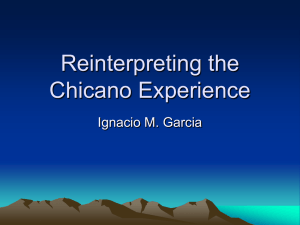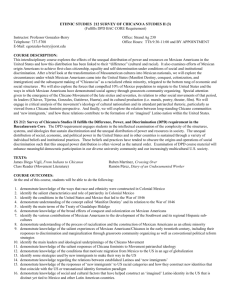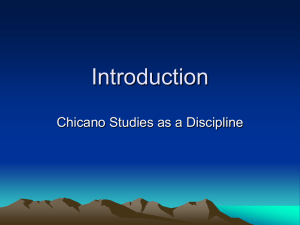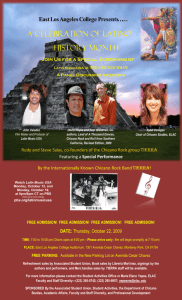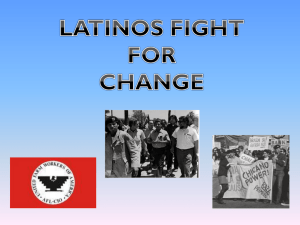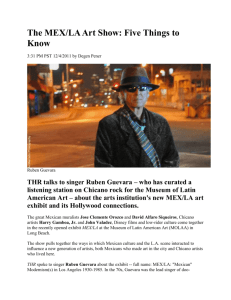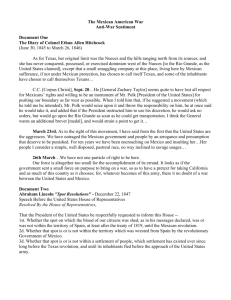the History of the Mexican American Civil Rights
advertisement
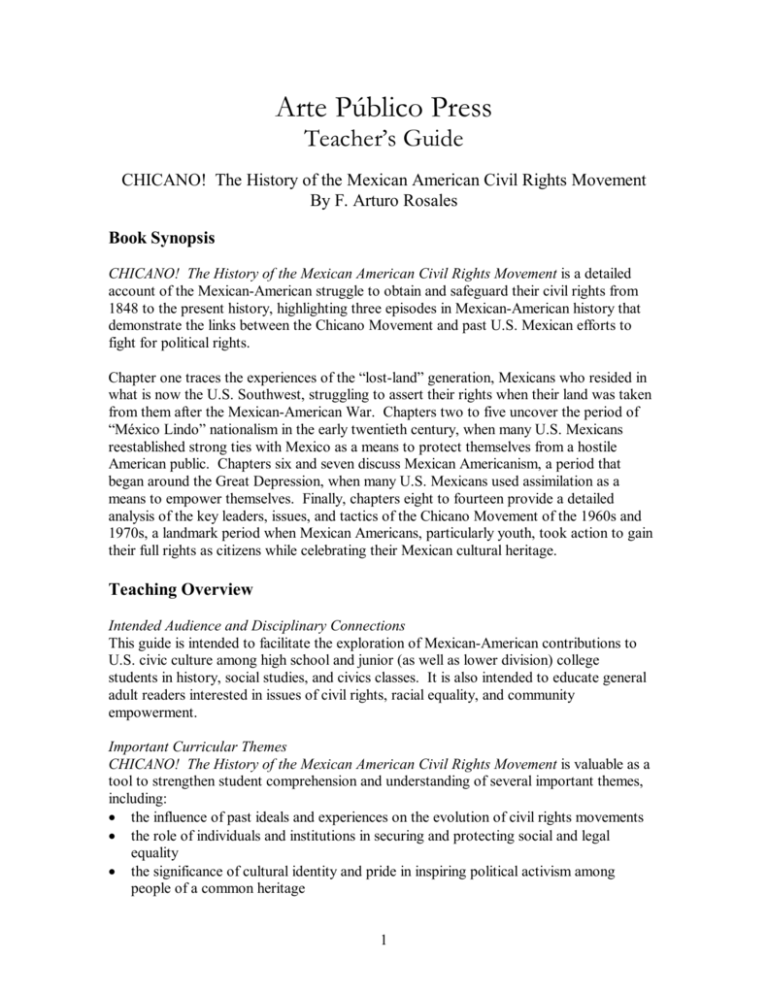
Arte Público Press Teacher’s Guide CHICANO! The History of the Mexican American Civil Rights Movement By F. Arturo Rosales Book Synopsis CHICANO! The History of the Mexican American Civil Rights Movement is a detailed account of the Mexican-American struggle to obtain and safeguard their civil rights from 1848 to the present history, highlighting three episodes in Mexican-American history that demonstrate the links between the Chicano Movement and past U.S. Mexican efforts to fight for political rights. Chapter one traces the experiences of the “lost-land” generation, Mexicans who resided in what is now the U.S. Southwest, struggling to assert their rights when their land was taken from them after the Mexican-American War. Chapters two to five uncover the period of “México Lindo” nationalism in the early twentieth century, when many U.S. Mexicans reestablished strong ties with Mexico as a means to protect themselves from a hostile American public. Chapters six and seven discuss Mexican Americanism, a period that began around the Great Depression, when many U.S. Mexicans used assimilation as a means to empower themselves. Finally, chapters eight to fourteen provide a detailed analysis of the key leaders, issues, and tactics of the Chicano Movement of the 1960s and 1970s, a landmark period when Mexican Americans, particularly youth, took action to gain their full rights as citizens while celebrating their Mexican cultural heritage. Teaching Overview Intended Audience and Disciplinary Connections This guide is intended to facilitate the exploration of Mexican-American contributions to U.S. civic culture among high school and junior (as well as lower division) college students in history, social studies, and civics classes. It is also intended to educate general adult readers interested in issues of civil rights, racial equality, and community empowerment. Important Curricular Themes CHICANO! The History of the Mexican American Civil Rights Movement is valuable as a tool to strengthen student comprehension and understanding of several important themes, including: • the influence of past ideals and experiences on the evolution of civil rights movements • the role of individuals and institutions in securing and protecting social and legal equality • the significance of cultural identity and pride in inspiring political activism among people of a common heritage 1 Reading Comprehension Strategies Before Reading: Initiate in-class discussions with students on topics that underscore the social and historical relevance of the work. Sample topics include: • Passages of the Declaration of Independence and the Constitution, including the Bill of Rights and important amendments that guarantee rights to women, former slaves, and other minorities • Manifest Destiny and how this ideology influenced U.S. involvement in the MexicanAmerican War • The Mexican-American War (1846-1848) and the Treaty of Guadalupe Hidalgo of 1848 • Major land acts, including the California Land Act of 1851 and the Homestead Act of 1862, and their impact on Mexicans in the United States • The Mexican Revolution of 1910-1917 and its impact on Mexicans in the United States • Compare periods of increased demand for Mexican temporary laborers (e.g., World War I and World War II) with periods of increased anti-Mexican sentiment that drove many laborers back to Mexico (e.g., the Great Depression, Operation Wetback) • The rise of nonconformist, counterculture, anti-establishment, youth-driven politics during the 1950s-1970s, including key leaders (e.g., Jack Kerouac, Neal Cassidy, Allan Ginsberg) • Key historical events and leaders of the African-American civil rights movement Many of the media and literary tools listed in this teaching guide can be readily incorporated into pre-reading activities. In addition, it may be useful to review with students the chronology provided on pages 279-282 to help improve their understanding of key events before and during the Chicano Movement (i.e., from 1836 to 1975). As Reading Progresses: Pose questions to students designed to improve reading comprehension. Sample questions include: Introduction • What were some of the Chicano Movement’s priority issues? What were its key slogans and tactics? What was the raison d’etre of the movement? • How did the African-American civil rights movement affect Mexican-American youth? How did it motivate them to become involved? • How was the Chicano Movement different from the African-American civil rights movement? Why is it not as well known to people? Chapter One: Americans by Conquest • How did Mexico’s North become America’s Southwest? What case did Anglos and the U.S. government make for expanding their country? What, specifically, was Manifest Destiny? • What was the Treaty of Guadalupe Hidalgo? What were some of its conditions? Were these conditions upheld? 2 • How were Mexicans who remained in the United States treated under U.S. rule? What happened to their lands and their political and economic power? How did Anglos justify the taking of property from Mexicans in the United States? Chapter Two: Legacy of the Mexican Revolution • How did the Mexican Revolution affect immigration to the United States? Why did Mexicans migrate to the United States during that time? • What was the U.S. reaction to the increased flow of Mexican immigrants across the border? What were some of the causes of fear and prejudice toward Mexicans in the early 20th century? • Did the Mexican Revolution have an affect on Chicano militancy? How? Chapter Three: Mexican Immigrants • What were the primary factors that led to the flow of Mexican immigrants during the 1900s? How did these factors contribute to both legal and illegal immigration? • How did the U.S. government treat Mexican immigrants? How did the Mexican government help Mexicans fleeing the United States? • Why was the plight of Mexican undocumented workers ignored during the early years of the Chicano Movement? Chapter Four: In Defense of México Lindo • How was the Chicano Movement inspired by the nationalism and “México Lindo” identity of Mexicans living in the United States in the late 1800s and early 1900s? • How did Mexican immigrants build up their own antidefamation infrastructure? How did they defend themselves against early civil rights abuses? • What were some of the priorities of the “México Lindo” movement? How was it a unifying force among Mexicans in the United States? Chapter Five: Organizing el México de Afuera • How did the Mexican government intervene on behalf of its early expatriates in the late 19th and early 20th century? How, in particular, were the Mexican consuls successful in assisting Mexicans in the United States? • What were some of the barriers to the Mexican government’s efforts? • Why, over time, did the Mexican government feel less accountable to Mexican Americans? Chapter Six: The Mexican-American Generation • What was Mexican Americanism and how was it different from “México Lindo” ideology? What circumstances brought it about? • What organizations emerged from and promoted Mexican Americanism? What were their primary issues and tactics? Who were some of their leaders? • How did the African-American civil rights movement and President Kennedy’s election set the stage for Chicano Movement activism? Chapter Seven: In Defense of the Workplace 3 • • • How were U.S. Mexicans treated in the workplace in the early 1900s? Why were they treated this way? How did their experience differ from that of white and AfricanAmerican workers? What was the role of Mexican Americanism in fostering labor unions? What gains came from union organizing and the numerous strikes? Why did “affirmative action” become a priority for U.S. Mexicans? Was this issue taken up by the Chicano Movement? Chapter Eight: The Struggle in the Fields • How did the farm worker movement evolve? Who were its primary leaders? Why did they feel it was important to unionize farm workers? How did they mobilize workers to unionize? • How were the Chicano and farm worker movements different? In what ways were their efforts linked? • How did the United Farm Workers Organizing Committee (UFWOC) take on the grape and lettuce industries? Were their efforts successful? How? Chapter Nine: In Quest of a Homeland • What was the Alianza crusade? What were its objectives? Did it achieve these objectives? Why or why not? • Did Alianza’s land grant activity benefit U.S. Mexicans? Why or why not? • How did Alianza activity affect the image of the Chicano Movement? Chapter Ten: The Fight for Educational Reform • How did Mexican-American youth, particularly college students in California, contribute to the development of the Chicano Movement? What were their tactics and priorities? What was the significance of El Plan Espiritual de Aztlán? • Who became the Chicano Movement’s key leaders? How were women’s issues addressed by the movement? • What were the East Los Angeles high school walkouts? Why were they significant? What motivated students to walkout? What did the walkouts accomplish? Chapter Eleven: The Chicano Moratorium • How did the so-called Brown Berets mobilize Chicano anti-Vietnam War protests? Why did they feel it was important for Chicanos to protest the war? • What was the Chicano Moratorium? Was it successful in achieving that purpose? What happened in its aftermath? • How did Los Angeles Times correspondent Rubén Salazar affect the Chicano Movement? Chapter Twelve: The Youth of Aztlán • How did differences in the expression of Chicanismo lead to clashes that made it difficult for activists to come together beyond a certain stage? • Why did Chicano identity politics evolve differently in California than in Texas, Arizona, and New Mexico? • Despite the differences, what were some of the common themes of the movimiento? 4 Chapter Thirteen: The Road to Political Empowerment • What was the La Raza Unida Party (LRUP)? How did Anglos respond to its efforts? • Do you think attempts to create a unified Chicano national party failed because of personality conflicts or because of differences in approach to issues among the leaders? • Were LRUP Chicanos ultimately successful in achieving political gains for Mexican Americans? Do you think the LRUP’s political legacy has allowed Chicano’s greater participation in the two-party political system? Why or why not? Chapter Fourteen: Legacy of the Chicano Movement • What key concepts and institutions of the Chicano Movement still have an effect on the Mexican-American community today? For example, what has been its legacy in academia? In the arts? In literature? In grassroots organizing? • How did the Chicano identity emerge in response to the experience of previous Mexican-American generations? What were its priorities in comparison with past priorities? • How has the creation of institutions such as the Mexican American Legal Defense and Education Fund (MALDEF) and the Southwest Voter Registration and Education Project (SVREP) strengthened the political participation of Mexican Americans? Writing/Composition Ideas Ask students to prepare a written assignment that demonstrates their comprehension and understanding of key concepts presented in the book. Sample paper topics include: • What historical period of time do you think most influenced the Chicano Movement? Was it the “lost-land” generation? México Lindo nationalism? Mexican Americanism? Pick one and explain why. • Do you think the United States had the right to annex the U.S. Southwest? Why or why not? • What are the primary reasons Mexicans have come to this country? Explain using several historical examples. • What leader do you think most influenced the Chicano Movement? Why and how? • Compare and contrast the approach and focus of at least two of the following Chicano leaders: César Chávez, Reies López Tijerina, José Angel Gutiérrez, and Rodolfo “Corky” Gonzales. • Explain why maintaining cultural identity is important. OR, explain why assimilation is important. • In what ways did youth make a difference in the Chicano Movement? • What can youth interested in civil rights today learn from the Chicano Movement? • How does your cultural heritage play a role in your own identity? What are some common themes that shape the culture with which you identify? • How was the Chicano Movement similar to the African American civil rights movement? How was it different? • Are Mexican Americans better off today because of the Chicano Movement? Why or why not? 5 Word and Terms Study • • • • • • • • • Anglo: An informal expression for an Anglo-American -- an English-speaking person, especially a white North American who is not of Hispanic descent. Aztlán: The mythical homeland of the Aztecs, said to have been situated geographically in the area of the five southwestern states obtained by conquest from Mexico as a result of the Mexican-American War (ceded to the United States in the Treaty of Guadalupe Hidalgo in 1848). This concept heavily influenced Chicano activism – to undo the injustice against Mexican Americans that started with U.S. imperialism and the unfair taking of land from Mexico. Chicano: A term for a Mexican American that took on political meaning when it was appropriated by many U.S. Mexican activists in the Southwest. While at times it has been used as a derogatory label for Mexicans who had recently arrived in the United States, it became a term of ethnic pride among Mexican-American activists during the 1960s and 1970s. Today, there is debate over continued use of the term. El Movimiento: Literally means “the movement” in English. A common term for the Chicano Movement. La Raza: Literally means “the race” in English. A common term for being of Mexican or Latino descent. Lost-Land Generation: Northern Mexican natives who lost their land as a result of the Mexican-American War and the U.S. annexation of this region to what is now the Southwest during the mid-nineteenth century. Mexican Americanism: A post-Great Depression ideology among Mexican Americans who sought equal rights while trying to acculturate to U.S. Anglo-dominated culture. Mexican Americanism was promoted primarily among U.S. second and third generation Mexicans who did not have strong ties to Mexico. Manifest Destiny: A policy of imperialistic expansion defended as necessary or benevolent. The notion evolved in the 19th-century doctrine to justify the right and duty of the United States to expand throughout the North American continent. México Lindo Nationalism: A sentiment of renewed allegiance to Mexico felt by many U.S Mexicans in the early twentieth century. “México Lindo” literally translates to “beautiful Mexico” in English. This nationalism evolved among Mexicans in the United States in response to the repression they experienced in American society. Word Study Note: Given that many of these words possess deep socio-political meaning, encourage students to conduct more in-depth analysis of these terms through paperback and on-line dictionary and encyclopaedia sources. This may also serve to enhance student reading comprehension. About the Author F. Arturo Rosales is the author of CHICANO! The History of the Mexican American Civil Rights Movement, Hispanics and the Humanities in the Southwest, Pobre Raza: Violence, Justice, and Mobilization among México Lindo Immigrants and other works. He is Professor of History at Arizona State University in Tempe. 6 Related Media/Literary Tools Audio-Visual: CHICANO! A History of the Mexican American Civil Rights Movement. 1996. A Coproduction of Galán Productions, Inc. and the National Latino Communications Center, in association with public television station KCET/Los Angeles. Books: Acuña, Rodolfo. Occupied America. New York: HarperCollins, 1988. Broyles-González, Yolanda. El Teatro Campesino: Theater in the Chicano Movement. Austin: University of Texas Press, 1994. Camarillo, Albert. Chicanos in a Changing Society: From Mexican Pueblos to American Barrios in Santa Barbara and Southern California, 1848-1930. Cambridge: Harvard University Press, 1979. Campa, Arthur. Hispanic Culture in the Southwest. Norman: University of Oklahoma Press, 1979. Cardoso, Lawrence. Mexican Emigration to the United States, 1897-1931. Tucson: University of Arizona Press, 1980. Chávez, John R. The Lost Land: The Chicano Image of the Southwest. Albuquerque: University of New Mexico Press, 1984. García, Ignacio M. United We Win: The Rise and Fall of La Raza Unida Party. Tucson: MASRC, University of Arizona, 1971. Gómez-Quiñones, Juan. Chicano Politics: Reality and Promise, 1940-1990. Albuquerque: University of New Mexico Press, 1990. *Gonzales, Rodolfo. Message to Aztlán: Selected Writings. Ed. A. Esquibel. University of Houston, Texas: Arte Público Press, 2001. Griswold del Castillo, Richard. The Treaty of Guadalupe Hidalgo: A Legacy of Conflict. Norman: University of Oklahoma Press, 1990. Gutiérrez, David G. Walls and Mirrors: Mexican Americans, Mexican Immigrants and the Politics of Ethnicity. Berkeley: University of California Press, 1995. *Gutiérrez, José A. A Gringo Manual on How to Handle Mexicans. University of Houston, Texas: Arte Público Press, 2001. Hart, John M. Revolutionary Mexico: The Coming and Process of the Mexican Revolution. Berkeley: University of California Press, 1987. Isuaro, Durán and H. Russell Bernard, eds. Introduction to Chicano Studies. NY: Macmillan Publishing Co., 1982. Kanellos, Nicolás. Thirty Million Strong: Reclaiming the Hispanic Image in American Culture. Boulder, CO: Fulcrum, 1998. Marin, Christine. A Spokesman of the Mexican American Movement: Rodolfo “Corky” Gonzales and the Fight for Chicano Liberation, 1966-1972. San Francisco: R and E Research Associates, 1977. Marin, Marguerite V. Social Protest in an Urban Barrio: A Study of the Chicano Movement, 1966-1974. Lanham MA: University Press of America, 1991. Márquez, Benjamin. LULAC: The Evolution of a Mexican American Political Organization. Austin: University of Texas Press, 1993. McWilliams, Carey. North from Mexico. Westport, CN: Greenwood Press, 1968. Muñoz, Carlos. Youth, Identity, Power: The Chicano Movement. London: Verso, 1989. 7 Navarro, Armando. Mexican American Youth Organization: Avant-Garde of the Chicano Movement in Texas. Austin: University of Texas Press, 1995. *Ramos, Henry A.J. The American GI Forum: In Pursuit of the Dream, 1948-1983. University of Houston, Texas: Arte Público Press, 1998. Reisler, Mark. By the Sweat of Their Brow: Mexican Immigrant Labor in the United States: 1900-1940. Westport, CT: Greenwood Press, 1976. Ruiz, Vicky. Cannery Women, Cannery Lives: Unionization and the California Food Processing Industry, 1930 – 1950. Albuquerque: University of New Mexico Press, 1987. Sanchez, George J. Becoming Mexican American: Culture and Identity in Chicano Los Angeles, 1900-1945. NY: Oxford University Press, 1993. Skerry, Peter. Mexican Americans: The Ambivalent Minority. NY: The Free Press, 1993. *Tijerina, Reies L. They Called Me “King Tiger”: My Struggle for the Land and Our Rights. Ed. and trans. J. Gutiérrez. University of Houston, Texas: Arte Público Press, 2000. Weber, David J. Foreigners in Their Native Land: Historical Roots of the Mexican Americans. Albuquerque: University of New Mexico Press, 1973. *Other Arte Público Press books. Acknowledgements This teaching guide has been prepared by Arte Público Press, the largest and most established publisher of Hispanic books in the United States. Arte Público Press is also the publisher of CHICANO! The History of the Mexican American Civil Rights Movement. Preparation of this study guide is made possible through support from the Kauffman, Mott and Rockefeller Foundations. 8
